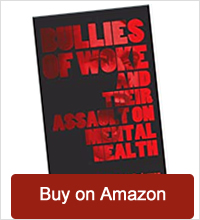Imagine a 52-year-old truck driver collapses over the wheel and slams into a school bus killing eight children. He’d had a heart attack.
Now imagine a 22-year-old man takes a gun, enters a theatre and shoots randomly, killing eight children. It seems he had an acute psychotic break.
The truck driver probably won’t go to jail. There was no intent. The community will feel empathy for him. There but for the grace of God…But the young man? He’ll be maligned and incarcerated. There is little room for forgiveness. Rather than empathy, there will be exclamations of horror. In truth, neither one is to blame for their illness or the tragic unpredictable events.
The word “mental” conjures fearful images: the “psycho” who stalks people and then stabs them repeatedly; the young man who takes a gun and sprays a stream of bullets in a room full of young children. “Mental” illness drags behind it a heavy bag of ignorance and confusion that has led to the stigma of shame and prejudice for those of us with the illness as well as our families, and continues to promote fear in the public square.
At the present time, the Criminal Code for defendants found not criminally responsible (NCR) are detained in forensic hospitals and their status reviewed every year. Justice Minister Rob Nicholson introduced Bill C-54 which will increase the time between reviews to three years.
We are listening to victims, as well as provinces and territories, who are telling us that the safety of the public should be the paramount consideration in the decision-making process involving mentally disordered accused persons.
The problem seems to be that the bill will not accomplish its goal. Justice Richard Schneider, chair of the Ontario Review Board said that very few of those the government wants to have held back would meet the criteria based on the wording of the bill. “Assuming there was a real problem with the current scheme, the proposed amendments completely miss the mark.”
Justice Schneider sees no reason to reason to change the system. He has come to the same conclusions as Ian Hunter regarding recidivism. Mr. Hunter, professor emeritus in the Faculty of Law at Western University wrote in the National Post, November, 27 2012, “Academic studies have shown that the recidivism rate for NCR accused is very low, somewhere in the 3-7% range. By comparison, the recidivism rate for parolees is at least double that, while the recidivism rate for those who complete a prison term is more than five times greater.” He added, “in the name of ‘victims’ rights,’ Stephen Harper’s Conservative government is now applying its tough-on-crime agenda against the most vulnerable constituency within the justice system: the mentally ill.”
Victims having to return each year for hearings will suffer. There is no doubt about that. I can’t imagine having to relive the horror over and over again. There is no question that having a member of one’s family murdered, and decapitated is beyond description, emotionally devastating, the stuff of nightmares. A mother or father murdering their children is unthinkable and unconscionable; and probably preventable if the right care had been available at the right time.
All victims of crime have to find ways to carry on with their lives. Whether the crime is committed by someone who is sane or not. As hard as this is to say, the feelings of the victims cannot be the compass by which justice is served. Our courts must balance justice and mercy, a concept bequeathed to us from ethical monotheism, 3,500 years ago, that continues to push us toward mercy and away from revenge. There was a time in this country when we believed in capital punishment. In my heart I believe there are crimes so evil, people so unredemptive, that they ought not to have the right to breathe. But, I am glad my government chooses not to take life.
After the beheading of Tim McLean by Vincent Li on a Greyhound bus in Manitoba in July 2010, Senator Michael Kirby said that the potential for violence is about the same whether you have a mental illness or you don’t have a mental illness — but the stereotype is quite different. “When you have a story like that, particularly one that was that gruesome, it stays in people’s minds and reinforces the negative view that a lot of people have.”
Louise Bradley, president of the Canadian Mental Health Commission, said she is concerned that too much emphasis on high-profile cases will give people a misleading picture of violence and mental illness. Dr. Patrick Baillie, lawyer and forensic psychologist is worried that changing the rules to a three-year wait between reviews could result in fewer NCR defences, with more mentally ill offenders choosing prison. “That creates the potential for mentally ill individuals to be back in the community (after detention) without having been able to access treatment.” Researchers found those designated NCR are less likely to re-offend than those convicted in a criminal court. Chris Summerville, head of the Schizophrenia Society of Canada also shared his concerns because there is no evidence of problems with the current system.
As Kim Mackrael reported in his article in the Globe and Mail March 16, 2013, “Mentally ill patients released from prisons are significantly more likely to re-offend than those released from hospitals after being found not criminally responsible.”
So what is the reason for this change? According to Julie Di Mambro, spokesperson to Justice Minister Rob Nicholson, “Victims are concerned that their safety is not being specifically taken into consideration by review boards when they make a disposition.”
We must not let fear overrule facts. Our government must not increase sentences because of the fear of the families of the victims. Our government would then be complicit in feeding our society’s fear of the mentally ill when our government ought to be leading us away from fear toward better understanding of the mentally ill, many types of mental illness and the many proven treatments available.
Mental illness is not and must not become a death sentence. Mental illness afflicts more than 20 per cent of our population; seven-million Canadians from all walks of life; rich, poor, young, old, educated, illiterate, all races, colours and creeds.
When the young man with the gun who shot at innocent children is treated with the same empathy as the truck driver with the illness in his body, we will know that we have reduced the stigma of mental illness that has been carried from centuries of misconceptions and fear.


